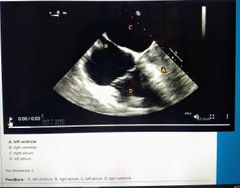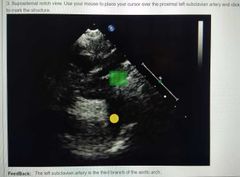![]()
![]()
![]()
Use LEFT and RIGHT arrow keys to navigate between flashcards;
Use UP and DOWN arrow keys to flip the card;
H to show hint;
A reads text to speech;
40 Cards in this Set
- Front
- Back
|
Which fetal cardiac shunt usually closes first after birth |
Ductus arteriosus |
|

|
. |
|

|
. |
|
|
4. During embryological development of the heart, six pairs of aortic arches form and atrophy or evolve into different structures. Which one formed the aortic Arch? |
The 4th Left |
|
|
1b. What portion of the aorta is located from the Isthmus of to the diaphragm |
Descending thoracic aorta. |
|
|
2b. Which of the following right ventricular wall segments is seen on a sub costal 4 Chamber View? |
Inferior wall segments |
|
|
3b. Which of the aortic valve leaflet is closest to the interatrial septum? |
Non coronary cusp |
|
|
4b. The aortic valve normally opens blank seen on an EKG |
Approximately 30 - 35 ms after the completion of the QRS wave |
|
|
1c. Which lab values are most important for a physician to review prior to scheduling a pericardiocentesis |
PT & INR Used to assess the coagulability or clot-ability of the blood. |
|
|
2c. Systemic blood pressure taken before a treadmill stress echo should be obtained with the patient in the |
Supine and standing positions |
|
|
3c. Carnitine deficiency is associated with: |
Dilated cardiomyopathy |
|
|
4c. The pulmonary capillary wedge pressure evaluated on a right heart catheterization should represent the pressure in the blank |
Left atrium |
|

1d. What is a potential cause for the abnormal swelling appearance in the contrast |
• High mechanical index settings |
|
|
2d. Which ultrasound technique has the highest temporal resolution |
• M-mode |
|
|
3d. All velocity and time interval measurement should be measured at a sweep speed of blank or greater |
• 100 mm/s |
|
|
4d. The thickness of the interventricular septum will be best visualized when: |
• US beam is perpendicular to the long axis of the septum |
|
|
1e. Which calculation is used to evaluate the effects of a vsd on the pulmonary and systemic flow |
• Qp/Qs |
|
|
2e. If the PISA radius for the mitral regurgitation is 1.0 CM. What should you do next to assess the level of Mr present? |
• PW Doppler the pulmonary vein |
|
|
3e. The proper placement of the emerald cursor or assessment of the EF% in the long axis view is: |
• between the papillary muscle head and the mitral leaflet tips |
|
|
4e. The left atrium volume measurement is performed during what portion of the cardiac cycle |
• end systole |
|
|
1f. Which of the following describes an apical View that is suboptimal |
• the LV Apex is rounded |
|
|
2f. Why is the apical 4 chamber view preferred for the Doppler evaluation of the mitral valve? |
• PW player is most accurate when the sample can be obtained with the incident and beam at a zero degree angle to the flow |
|
|
3f. What is the most reliable method for diagnosing cardiac tamponade |
• Doppler evaluation of mitral inflow velocities during normal respiration |
|
|
4f. What abnormality is demonstrated using saline contrast while performing in PLAX view of the heart |
• persistent left SVC |
|
|
1g. What usually causes a slow, gradual onset of MR? |
• Rheumatic fever |
|
|
2g. A 62 year old female presents with dyspnea and htn. The echo demonstrates a tricuspid regurgitation jet with a peak velocity of 3.2 meters per second and a right ventricular free wall measures 0.7 CM. What is the most likely diagnosis for these findings |
• pulmonary hypertension |
|
|
3g. Diastolic flow reversal in the hepatic veins, diminished s velocity and prominent a wave on a pulmonary venous tracing, with a mitral either a ratio of 1. And 9 correlates with which pathology |
• constrictive pericarditis |
|
|
4g. SWA performing an echo you note that there is apical displacement of one or more tricuspid leaflets for the Chinese Crested and newest is in the normal position. Which of the following describes the findings? |
• ebstein's anomaly |
|
|
1h. Which of the following parts of the complete atrioventricular septal defect associated with trisomy 21? |
• ostium primum defects Trisomy 21 = down syndrome |
|
|
2h. A patient with a history of rheumatic fever presents with an early diastolic snap heard and a rumbling diastolic murmur what is the most likely finding on the echocardiogram for this patient? |
• mitral stenosis loud S1 snap |
|
|
3h. All of the following carry a higher risk for developing coronary artery disease |
• steroid therapy, IDDM, htn |
|
|
4h. Flattening of the ventricular septum is not an expected finding with |
• 3 mm muscular vsd |
|
|
1i. Mitral stenosis will blank the pressure halftime of the flow across the valve |
• an increase in |
|
|
2i. |
• |
|
|
3i. A patient presents for an Echo due to a recent diagnosis of renal cell carcinoma. What cardiovascular structure should be closely evaluated for changes related to the recent diagnosis? |
• IVC |
|
|
4i. Aortic dissection originates in the proximal ascending aorta and is confined to that portion of the aorta. What Debakey classification |
• DeBakey type 2 |
|
|
1j. Tachycardia, dyspnea, orthopnea, and lower extremity edema are clinical findings that are most suggestive of: |
• dilated cardiomyopathy |
|
|
2j. What heart sound is associated with tricuspid stenosis |
• opening snap due to limitations in valve Motion in diastole |
|
|
3j. How does restrictive cardiomyopathy affect pulmonary venous |
• blunted systolic velocity and increase diastolic velocity |
|
|
4j. Asking a patient with constrictive pericarditis to take in a deep breath will cause: |
• a decrease of the mitral a velocity >25% |

